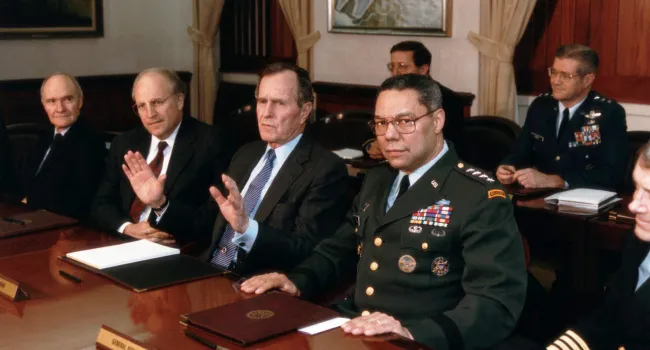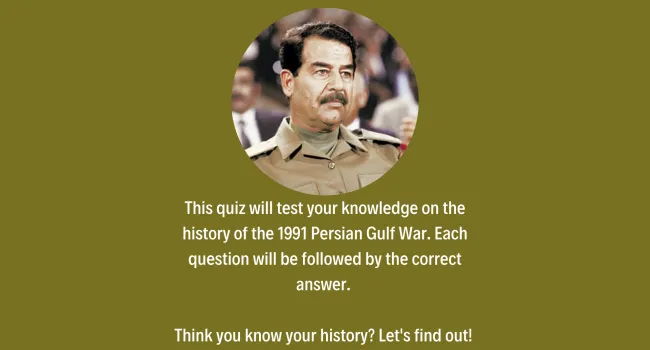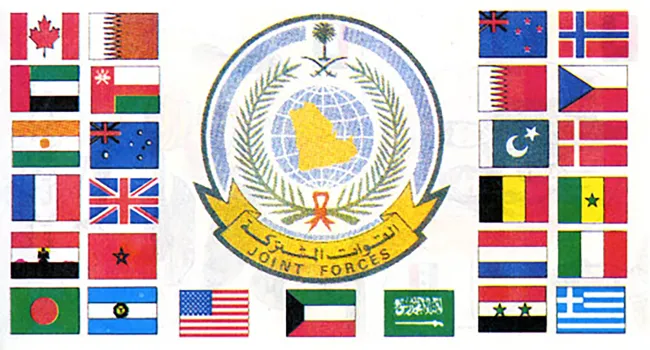Allied Coalition: A group of over 35 nations which took part in the liberation of Kuwait after invasion by Iraqi military forces under Saddam Hussein.
Colin Powell: Chairman of the U.S. Joint Chiefs of Staff during the Persian Gulf War.
Fahd bin Abdulaziz Al Saud: King of Saudi Arabia during the Persian Gulf War. After the invasion of Kuwait, there was a possibility that the Iraqi military would also invade Saudi Arabia. After meeting with Secretary of Defense Dick Cheney, King Fahd greenlit Operation Desert Shield.
George H.W. Bush: President of the United States during the Persian Gulf War. He was the 41st President of the U.S.
Hosni Mubarak: President of Egypt during the Persian Gulf War. Egypt was one of America’s closest allies in the Middle East, and Mubarak attempted to negotiate with Saddam Hussein to prevent a possible invasion of Kuwait.
Iran-Iraq War: Conflict between Iran and Iraq between 1980 – 1988. After the pro-western Shah of Iran was overthrown in 1979 and replaced with Shiite Muslim leader Ayatollah Khomeini, Khomeini encouraged Shiite Muslims in surrounding Persian Gulf kingdoms to revolt against their Sunni leaders. The war was a stalemate; ending by a U.N. sanctioned ceasefire in 1988. Iraq incurred a massive debt following the Iran-Iraq War, and Iraq’s inability to pay back its creditors was one of the main causes of the invasion of Kuwait.
Margaret Thatcher: Prime Minister of Great Britain during the Persian Gulf War. England was one of America’s closest allies in the Coalition against Saddam Hussein.
Mikhail Gorbachev: Premier of the Soviet Union during the Persian Gulf War.
Norman Schwarzkopf: A.K.A. “Stormin’ Norman”, Schwarzkopf was the supreme allied commander of Coalition forces during the Persian Gulf War.
OPEC: Organization for Petroleum Exporting Countries: an oligopoly in the oil industry, which work together to control oil production, prices, and affect the world-wide energy supply market.
Operation Desert Shield: Beginning on August 7, 1990, Operation Desert Shield’s purpose was to defend the kingdom of Saudi Arabia from possible invasion by the Iraqi military. This was the largest single movement of American troops ever made since World War II.
Operation Desert Storm: Beginning January 17, 1991, Operation Desert Storm was a massive allied air campaign which destroyed much if Iraq’s infrastructure and military strongholds. Much of Iraq was destroyed because of these allied “sorties”. After running out of targets, a ground war looked increasingly likely, which led to Operation Desert Sabre.
Operation Desert Sabre: Beginning February 24, 1991, Desert Sabre was a massive allied ground offensive that was launched northward from northeastern Saudi Arabia into Kuwait and southern Iraq, and within three days, Arab and U.S. forces had retaken Kuwait city in the face of crumbling Iraqi resistance.
Richard “Dick” Cheney: Secretary of Defense under President George H.W. Bush during the Persian Gulf War.
Sabah al-Ahmad al-Jaber al-Sabah: Emir of Kuwait during the Persian Gulf War.
Saddam Hussein: Leader of Iraq during the Persian Gulf War, he was a dictator who served as the fifth President of Iraq between 1979 – 2003. Hussein was responsible for the invasion of Kuwait, which kicked off the Persian Gulf War following the Iran-Iraq War.
U.N. Resolution 660: Condemnation of Iraq’s invasion of Kuwait. The U.N. Security Council also called for the immediate withdrawal of Iraq’s forces out of Kuwait.
U.N. Resolution 661: Economic boycott of Iraq placed by the U.N. Security Council
U.N. Resolution 674: Established January 15, 1991, as Iraq’s deadline for total withdrawal out of Kuwait.
Wafic Al-Samarrai: Iraqi general formerly chief of Iraqi general military intelligence born in the region of Samarra.







